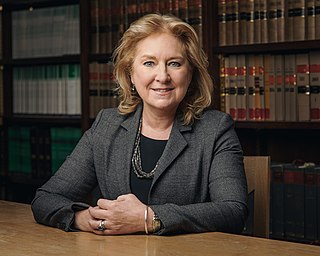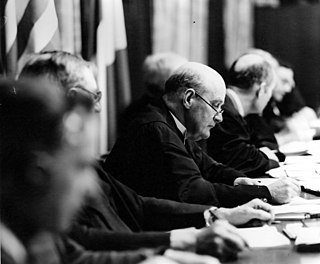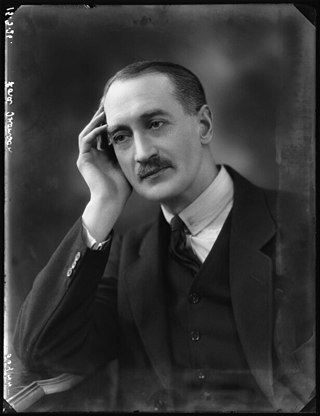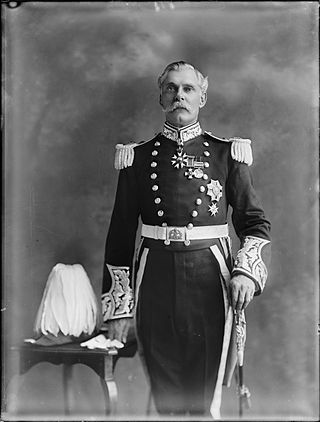Arms
  |
|
Charles Trevor Lawrence, 2nd Baron Trevethin, DSO, DL, MA (29 May 1879 [1] -25 June 1959 [2] ) was a British Army officer and peer. [3]
He was the eldest surviving son of Alfred Lawrence, 1st Baron Trevethin, a British lawyer and judge who served as Lord Chief Justice of England from 1921 to 1922; and the brother of Geoffrey Lawrence, 1st Baron Oaksey, the main British Judge during the Nuremberg trials after World War II, and President of the Judicial group.
He was educated at Haileybury and New College, Oxford. He then served with distinction in the Royal Horse Artillery: [4] during World War I he was Mentioned in despatches three times and awarded the DSO and the Order of St. Anna. He was made a Deputy Lieutenant of Breconshire in 1949.
  |
|

The Lady Chief Justice of England and Wales is the head of the judiciary of England and Wales and the president of the courts of England and Wales.

Geoffrey Lawrence, 3rd Baron Trevethin, 1st Baron Oaksey, was the main British judge during the Nuremberg trials after Second World War, and President of the Judicial group.

Baron St Levan, of St Michael's Mount in the County of Cornwall, is a title in the Peerage of the United Kingdom. It was created on 4 July 1887 for the former Member of Parliament Sir John St Aubyn, 2nd Baronet, becoming John St Aubyn, 1st Baron St Levan. He had previously represented Cornwall West in House of Commons as a Liberal and St Ives as a Liberal Unionist. He was succeeded by his eldest son, the second Baron, who was a Colonel and Honorary Brigadier-General in the Grenadier Guards. On his death the titles passed to his nephew, the third Baron, the son of the Hon. Sir Arthur James Dudley Stuart St Aubyn (1867–1897), second son of the first Baron. The third baron was succeeded in 1978 by his eldest son, the fourth baron, who had served with the Royal Navy at Dunkirk and in a minesweeper in Arctic Convoys during World War II and was awarded the Distinguished Service Cross (DSC). As of 2014, the titles are held by the fourth Baron's nephew, the fifth Baron, who succeeded in 2013.

Baron Trevethin, of Blaengawney in the County of Monmouth, is a title in the Peerage of the United Kingdom. It was created in 1921 for the prominent judge Sir Alfred Lawrence, Lord Chief Justice of England from 1921 to 1922.

Admiral Thomas Graves, 1st Baron Graves, KB was a British officer of the Royal Navy and a colonial official. He served in the Seven Years' War and the American War of Independence. He was also the Commodore-Governor of Newfoundland for a period of time.

John Laird Mair Lawrence, 1st Baron Lawrence,, known as Sir John Lawrence, Bt., between 1858 and 1869, was a prominent British Imperial statesman and served as the Viceroy of India from 1864 to 1869.

Christopher Birdwood Thomson, 1st Baron Thomson, was a British Army officer who went on to serve as a Labour minister and peer. He served as Secretary of State for Air under Ramsay MacDonald in 1924 and between 1929 and 1930, when he was killed in the R101 disaster.

John Poynder Dickson-Poynder, 1st Baron Islington,, born John Poynder Dickson and known as Sir John Poynder Dickson-Poynder from 1884 to 1910, was a British politician. He was Governor of New Zealand between 1910 and 1912.

Gordon Hewart, 1st Viscount Hewart, was a politician and judge in the United Kingdom.

Alfred Tristram Lawrence, 1st Baron Trevethin, PC was a British lawyer and judge. He served as Lord Chief Justice of England and Wales from 1921 to 1922. He is best remembered for the questionable manner in which he became Lord Chief Justice, under a plan devised by David Lloyd George.
Edward Kenelm Digby, 11th Baron Digby,, also 5th Baron Digby in the Peerage of Great Britain, was a British peer, soldier and politician.
Stubbington House School was founded in 1841 as a boys' preparatory school, originally located in the Hampshire village of Stubbington, around 1 mile (1.6 km) from the Solent. Stubbington House School was known by the sobriquet "the cradle of the Navy". The school was relocated to Ascot in 1962, merging with Earleywood School, and it closed in 1997.

Francis Raymond Evershed, 1st Baron Evershed, PC was a British judge who served as Master of the Rolls, and subsequently became a Law Lord.
Algernon William John Clotworthy Skeffington, 12th Viscount Massereene and 5th Viscount Ferrard, DSO was British Army officer and an Ulster Unionist member of the Senate of Northern Ireland from 1921 to 1929. During this period he served as Deputy Leader of the Senate and Parliamentary Secretary in the Department of the Prime Minister.
Lieutenant-Colonel Edward Gaspard Ponsonsby, 2nd Baron SysonbyDSO, was an officer of the British Army and a member of the House of Lords.

Shane Edward Robert O'Neill, 3rd Baron O'Neill was an Anglo-Irish peer and British Army officer. He served during World War II and was killed in action in Italy.

Patrick John Tristram Lawrence, 5th Baron Trevethin and 3rd Baron Oaksey, is a British barrister, hereditary peer and crossbench member of the House of Lords. He was educated at Christ Church, Oxford.
John d'Henin Hamilton, 3rd Baron Hamilton of Dalzell,, was a British peer and courtier. He served with the Coldstream Guards during the Second World War, and after succeeding his uncle in the peerage in 1952, became a Lord-in-Waiting and Lord Lieutenant of Surrey.

Godfrey Walter Phillimore, 2nd Baron Phillimore was an English peer, soldier and author.

Alfred Clive Lawrence, CBE, commonly known by his middle name, was a British barrister, who was HM Procurator General and Treasury Solicitor from 1923 until his death in 1926.